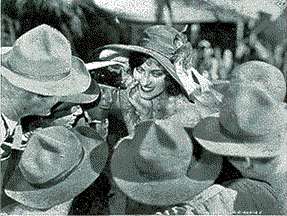| CAST: Sadie Thompson, Gloria
Swanson (1897-l983); Sergeant Timothy O'Hara, Raoul
Walsh (1887-1980); Alfred Davidson, Lionel Barrymore (1878-1954);
Mrs. Alfred Davidson, Blanche Frideric; Dr. Angus McPhail,
Charles Lane (1869-1945); Mrs.Angus McPhail, Florence Midgley
(1890-1949); Joe Horn,
James A. Marcus (1867-1937);
Ameena, Sophia Artego; Quartermaster Bates, Will Stanton (1885-1969)
This was the first and finest of
three screen adaptations of Somerset Maugham's short story called "Miss
Thompson." Before this movie adaptation, the story had been adapted as
the stage play called "Rain," which made actress Jeanne Eagels a stage
sensation. This original film adaptation won two Oscar nominations
for 1927-28. Gloria Swanson was nominated as Best Actress, and George Barnes
received a nomination for Cinematography.
Ms. Swanson had to fight hard with
the Hays office to make this film, as the play "Rain" was declared strictly
off limits. This is part of the reason why it was filmed under
the title of Sadie Thompson. Its plot has Swanson in the lead
role of Sadie Thompson, a San Francisco prostitute who is seeking to start
a new life, but is temporarily detained on an island which happens to be
the current target of reformer Alfred Davidson, who seeks to rid the island
of sin. Davidson and Thompson clash when she befriends a group of
Army men, and she is accused of immorality with the men, one of whom she
falls in love with -- Sergeant Tim O'Hara. Davidson makes it a point
to have O'Hara confined to quarters, and he threatens to have Thompson
deported back to San Francisco, a city that he finds out Thompson has fled
from because she was framed for a crime
she did not commit. Faced
with the prospect of going back to prison instead of to Australia to start
a new life with O'Hara, Thompson must find a way to keep Davidson from
sending her back to San Francisco.
Sadie Thompson is
highly acclaimed as the greatest performance of Gloria Swanson's career,
and this reviewer supports that acclaim- The author goes further to say
that Swanson's performance in this film was better than the three performances
that Janet Gaynor was given the first Best Actress Oscar for. Gaynor's
performances were definitely Oscar-worthy, but still fall short of Swanson's
performance in this film and Marion Davies' performance in The Patsy
(1927).
In praising Swanson's performance,
we cannot overlook the terrific performance given by Lionel Barrymore as
the evil reformer. His performance should have been at least nominated
for the Best Actor Oscar. Film critic Danny Peary's Alternate Oscars
lists Barrymore as among those he felt deserved Oscar nominations for 1927-28.
Lip readers had fun with this film, as there are a number of sequences
in which Swanson used profanity. No profanity appears in the titles except
for one in which Thompson tells Davidson "HANG ME AND BE DAMNED!" Swanson's
answer to the Hays office was that one could not censor what one could
not hear. For many years, this film remained unseen becasue the one
and only surviving print of Sadie Thompson was missing the
final reel. Dennis Doros did the world a fabulous service in 1987
when he reconstructed the last reel using titles, stills, and film footage
from other parts of the film where appropriate. At last, this masterpiece
is back before the public where it belongs, and this restored version is
available from Kino Video.
Sadie Thompson is
among the finest dramatic achievements of the 1920s, and is a film that
every classic/silent film enthusiast should have a copy of. |
